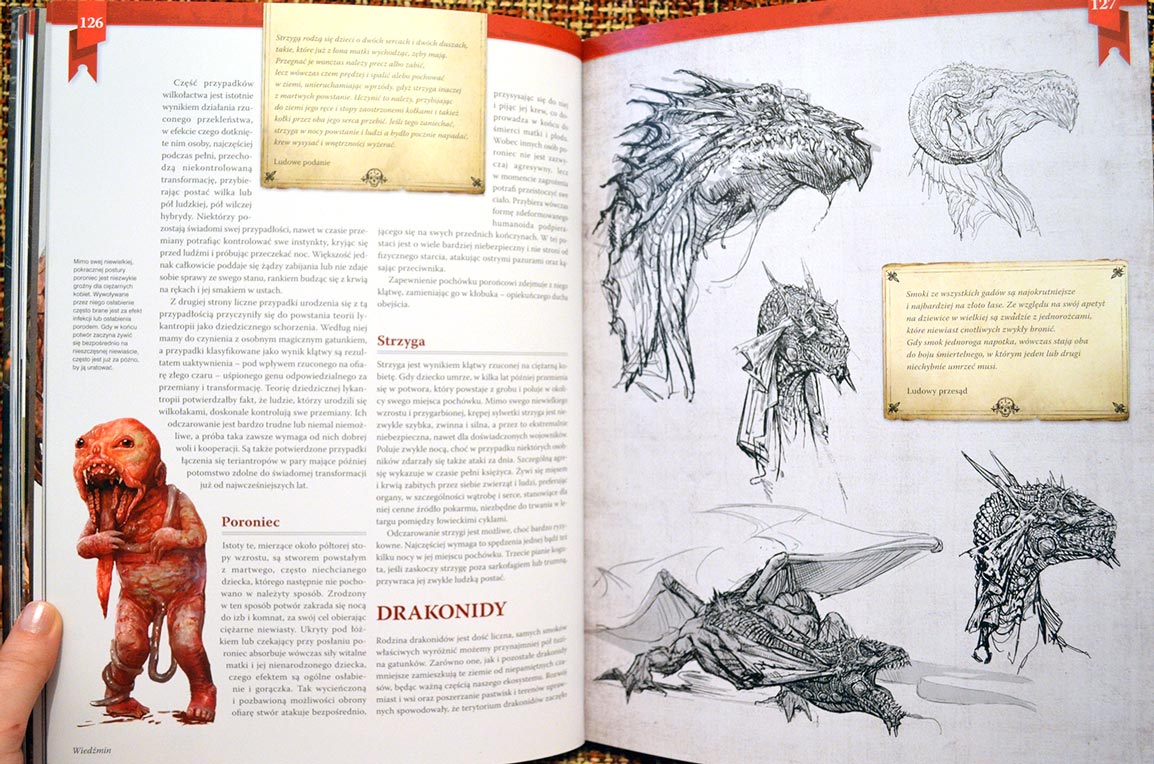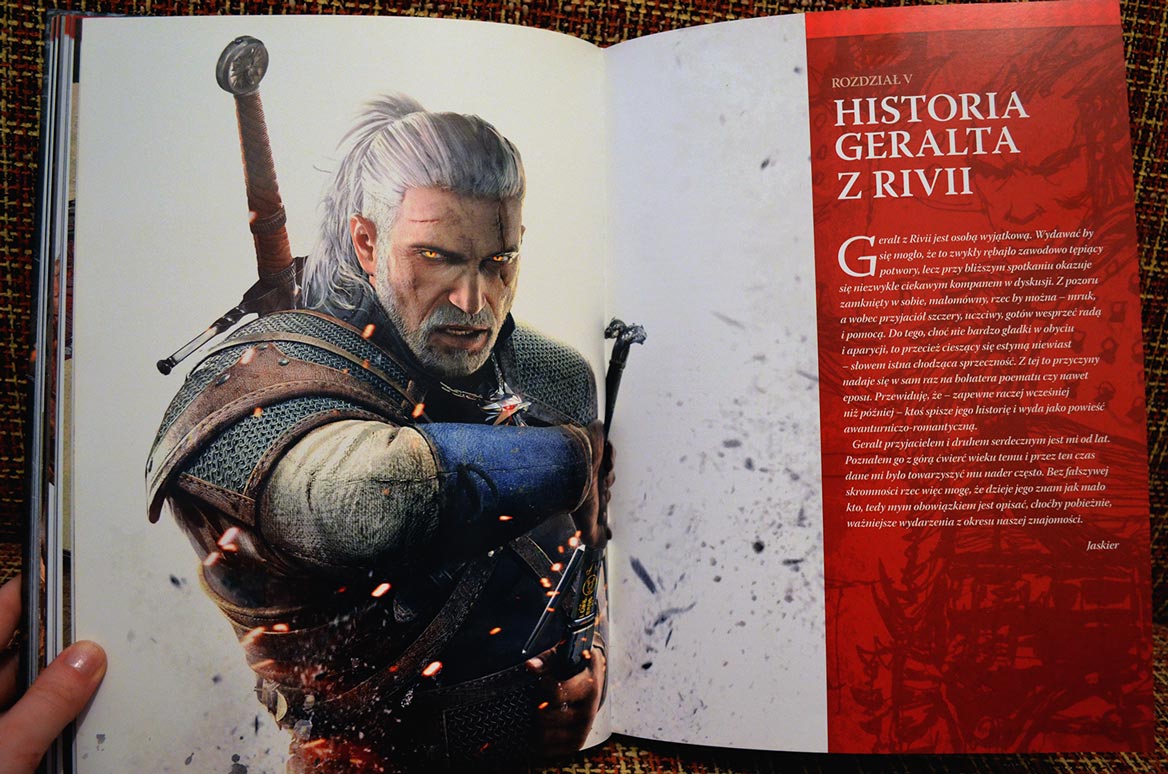The Witcher artbook – The World of the Witcher: Video Game Compendium review

Finally, I have the time to write about The World of the Witcher: Video Game Compendium.
For a long time, I wanted to make this review. However, I saw that there are already articles on the internet reviewing this artbook, and at first, I found it pointless to write something that was already written.
But after reading the book and other reviews, I just need to write my own one. There are so many things that have been omitted, that I can not hold myself back.
I have to warn you, this will be a long read, but in exchange:
- I will show you the pages and illustrations of one of the best art books I have ever read, and reveal a few secrets that could be unnoticed by someone who doesn’t know well Poland/Slavic mythology and legends that influenced the world of The Witcher. We will also take a try to decrypt one of the first Slavic alphabet – Glagolica, used in some of the illustrations.
- Introduce to you a few of the illustrators that created artworks for CD Project RED ( their artworks are included in The World of the Witcher: Video Game Compendium )
Ps. I received this artbook as a gift, and it’s written in the Polish language. You can get The World of the Witcher: Video Game Compendium in the English language here.
Introduction to The World of the Witcher: Video Game Compendium
I assume that you already know The Witcher. But if you don’t, a brief explanation:
The Witcher is a fantasy series of novels and short stories written by Polish author Andrzej Sapkowski. Based on the novel series, there were created comics, TV series, and of course the famous “The Witcher” game series developed by CD project Red.
The artbook contains in-depth knowledge about the locales, the deadly beasts that inhabit them, and the lethal weapons used to put them down. It’s a compendium of The Wicher game series. However, I refer to it as an artbook, because of the number of illustrations and concept arts included in this book.
The World of the Witcher: Video Game Compendium
The Witcher artbook – The World of the Witcher: Video Game Compendium PREVIEW
The cover

The book has a thick protective cover with an epic design based on the Witcher’s suit. The title is UV varnished, to create this nice gloss effect, which you can see in the gif above. It adds +10 points to the “wow” effect 🙂
The book is quite heavy (or I’m just so weak), and had some problems when I tried to record the gloss effect. At the beginning, I wanted to record also the back of the cover, but when I was holding the book in one hand for too long (in the other I’m holding the camera) my hand was trembling like I had an Alzheimer. I guess it’s finally time to get a tripod for my camera, or visit the gym.
The content
The book is created in an interesting way – it’s divided into sections, that are “written” by different characters we meet in The Witcher game – most importantly Jaskier, who is portrayed as the main author of this compendium.
The sections are written accordingly by characters that are most familiar with the topic, so in the book, we will also find notes from Villentretenmerth (Borch trzy kawki), Vesemir, Yennefer and Geralt.
Table of Contents
Introduction (written by Jaskier)
1. The World and Its inhabitants (by Villentretenmerth)
2. The Witchers (by Vesemir)
3. The Magic and Religions of the Continent (by Yennefer)
4. The Beasts of the Northern Kingdoms (by Geralt)
5. The Story of Geralt of Rivia (by Jaskier)
1. The World and Its inhabitants
This part, written by Villentretenmerth, describes The Witcher’s world. We can learn from it about the history from times before humans inhabited the continent to the times when humans ruled over it, read about geography and kingdoms of the continent
It’s said that Villentretenmerth was chosen to write this part due to his longevity, thanks to which he was able to see many of the described historical events with his own eyes, such as Formation of the North Kingdoms and wars with non-humans, and later – Conflicts with Nilfgaard.
I was really enjoying reading this part, the writing style inclines the curiosity that Villentretenmerth bestows on humankind which is, often mentioned in the books, very rare for dragons, and the authors of The Witcher compendium made an effort to show it.
Apart from geography and kingdoms in The Witcher world, in this chapter, we can also read about Nonhumans and their history: Elves, Driads, and Dwarfs. This part very helpful to get a better understanding of the tense situation between different races.
This chapter contains many Illustrations and concept arts of game locations, architecture buildings, mountains, description of the kingdoms, and illustrations of kings.
2. The Witchers
The next part is written by Vesemir, the Geralt’s mentor and father figure. He was chosen to write this part because of his experience and sincerity – as Jaskier said, any disagreements or omissions of facts that may have been there are solely due to the fact that Vesemir was at an advanced age at the time of writing the story, and to the love of a profession that had been the meaning of his life for so long.
Vesemir tells us the story of the Witcher schools -why, and how they were created. We will get to know the details about the life of a Witcher – how someone becomes a Witcher, what mutations they are undergoing, the training an weapons they use.
There’s even a part about the price for the service and recommendations concerning the contact with client, and where to look for the job.
Concept art of the weapons/ swords and the descriptions on how its made and what materials used to create the swords.
3. The Magic and Religions of the Continent
In this chapter, we will learn about how magic works in this world, and what religions are cultivated on the continent. I thought that this part, especially religions will be told by Nenneke, however, Jaskier entrusted this task to Yennefer:
My original intention was to quote here the venerable Melitele, Mother Nenneke, but after reflection, I thought that the opinion of an educated person, but not directly involved in matters of faith would allow to maintain a more objective view of this delicate topic.
So, as we can learn about Witchers and the Witcher schools from Vesemir in the previous chapter, here we will learn everything about magic – The Chaos, how it works, what predisposition you need in order to be able to possess its power, who is The Source, and what importance and characteristics have The Elements in sorcery.
Here we will also find information about schools and the magic education.
Religions in The Witcher’s World
This part was written by Yennefer also because Magic and The Religions topics are related.
In the opinion of wizards, magic and the effect of prayers are the same manifestations of power, but the way priests do this still remains an unexplained mystery. The fact is that some are able to manipulate power as well as wizards, without any training, study or preparation.
So, in this part we will find description of cults: Melitele, Kreve, Druidry, Freya and Skellige cults, Lebioda and his “Good Book”, Eternal Fire and Cult of Lionheaded Spider.
 * These statues were probably inspired by an existing Idol, the Zbruch Idol, in Poland known as Svetovid from Zbruch.
* These statues were probably inspired by an existing Idol, the Zbruch Idol, in Poland known as Svetovid from Zbruch.

* This illustration reminds me of the wooden chapels, often seen near village’s roads. Kapliczki przydomowe, or kapliczki przydrożne (roadside shrines) aren’t a relict. They are still being built.

They were put up for various reasons, sometimes for example as a votive offering in thanks for favors, from the foundation of someone who received these favors. Often the founders wanted to redeem their faults or ask for special favors. Therefore, chapels were built with a specific intention: for example, for the health of the child or for abundant crops. They were also built in thanks for healing, with regret for sins or for protection against plague or fire.
I was raised in a small polish village, there are 3 chapels (dedicated to Saint Mary).
4. The Beasts of the Northern Kingdoms
Finally, the most interesting part of this book, told by the famous Gwynbleidd, Geralt of Rivia.
His words and stories were written down by Jaskier while they traveled together.
His in-depth knowledge of the subject never ceases to amaze me, and I spent many evenings listening to Witcher tales of the habits of various beasts and monsters, as well as refuting the erroneous, obviously fabricated myths that preoccupied the mind of an ordinary man. Here you will find his words that I managed to put on paper, both as a reminder and as a warning.
I’m not sure where to start, this is the part that has descriptions of the Monsters, and most importantly – amazing illustrations and concept arts of described monsters
The whole chapter is divided into few parts: Necrophage Vampires, Intangible emanations, Hybrids, Cursed beings, Draconids, Insectoids, Magical beings and constructs, Ogroids, Relicts.
5. The Story of Geralt of Rivia
The last chapter, this time written by Jaskier himself, tells us the story of Geralt’s and his friends – focusing mostly on Ciri, Geralt’s adoptive daughter.
It start with the story of how Jaskier and Geralt meet each other, and their first adventures. The stories are told obviously from Jaskier’s perspective, in his tone, so reading these colorized stories (despite knowing them from books) is interesting and entertaining.
Briefly saying, this chapter is a summary of all events, from the beginning when Jaskier meet Geralt, Yennefer and Ciri, to the end, when the Ciri decided to step into the portal on the Undvik island, to change the fate of their world.
What happened after that? Is this the end of the book?
Well, as a final word, I sympathize with Jaskier’s opinion:
With a good novel, it should be like a feast – you should finish it at such a moment that when you get up from the table, be neither thirsty nor drunk.
Interesting facts about The Witcher compendium
Glagolica in The Witcher illustrations
Some of the illustrations attracted my attention because of the sentences written in Glagolitic script, which is used by CD Project Red as the most widespread writing system in the Northern Kingdoms. in the world of The Witcher.
What is Glagolica?
Glagolica (Głagolica, Glagoljica, Glagolitsa, Glagolitic script) – It is the oldest known Slavic alphabet created by Cyril and Methodius (it’s said that it was created basing on already existing Slavic alphabet). It was used also in Poland till Pope Stefan V (VI) forbade the use of the Slavic language in the liturgy and ordered to restore the Latin rite.

Here’s a instruction how to write the Glagolitic script

Okay, we have this brief explanation behind us. Let’s try to translate the script.
During my high school years, somehow I heard about the existence of Glagolica, and decided to learn it. The Polish language is “compatible” and I love that with Glagolitic script I can write “szcz” as one letter. I never suspected I will need this knowledge for something else than writing cheat sheets in glagolica to use the sheets as a cover of my notebook, and leave it on my desk during the exams.
Nadal Hetero

The character in this illustration is holding on his back a sign:
ⱀⰰⰴⰰⰾ ⱈⰵⱅⰵⱃⱁ
NADAL HETERO
*It’s Bulgarian Glagolica transcription, can’t use the Hrvatska glagolica letters here. The biggest difference is the letter ⰴ (d).
The sign means “NADAL HETERO” which can be translated from the polish language to English as NADAL – “still”, HETERO – other, another, different.
I have no idea if someone just wanted to make a joke and there’s no deeper meaning, just a sentence “I’m still hetero”, because that what it sounds like to me. Let me know if you have any ideas what it means in the comments 😀
Memento Mori Vanitas

ⰏⰅⰏⰅⰐⰕⰑ
ⰏⰑⰓⰋ ⰂⰀⰐⰋⰀⰔ
ⰐⰋⰎⰗⰃⰀⰀⰓⰄ
ⰅⰏⰒⰋⰓⰅ
ⰐⰀⰖⰔⰋⰜⰀⰀ
MEMENTO
MORI
VANITAS
NILFGAARD
EMPIRE
NAUSICAA
And here we have a symbolic reminder of the inevitability of death. Memento Mori – ‘remember that you must die’
and Vanitas – ’emptiness’, ‘futility’, or ‘worthlessness’. Vanitas vanitatum et omnia vanitas – vanity of vanities; all is vanity.
Vanitas are closely related to memento mori still lifes which are artworks that remind the viewer of the shortness and fragility of life. Common vanitas symbols include skulls, which are a reminder of the certainty of death.
Nilfgaard empire – that’s an easy one, it’s the most powerful empire in the history of the Witcher’s World.
Nausicaa – Nauzicaa (or Nausicaa), also known as the “Skullheads” or “Death’s Heads“, was a brigade of the 4th Cavalry Army, Nilfgaardian mounted troops.
The illustration reminds me of panel paintings in churches, or illustrations in books from medieval manuscripts.
Any cons?
Yes, there’s one thing that the book certainly lacks of. The list of artists.
I know that a lot of artists worked on The Witcher project, and the book contains 3d models, renderings, illustrations and concept art. And many of these artworks are a group project and it would be hard to list every person who worked on a certain art included in this book.
But I’m the kind of person who, if likes a certain artwork, tends to google its artist’s name and follow their art pages – and it’s a big deal to me. So, seeing an amazing illustration, and not being able to identify who created it is something that shouldn’t take place.
Artists featured in The World of the Witcher: Video Game Compendium
I did a little investigation on the internet to find artists whose artworks are included in The Witcher artbook. Below is a list of some names I found.
Unfortunately, I’m not able to find all names (especially of 3d artists/modelers) so if you know artists whose artworks are included in the book but are not listed here, please let me know!
I added to the artist’s names their Artstation gallery – you can follow them there, they have plenty of other amazing illustrations published on the Artstation 🙂

Bartlomiej Gawel (rendered by Pawel Brudniak)

































